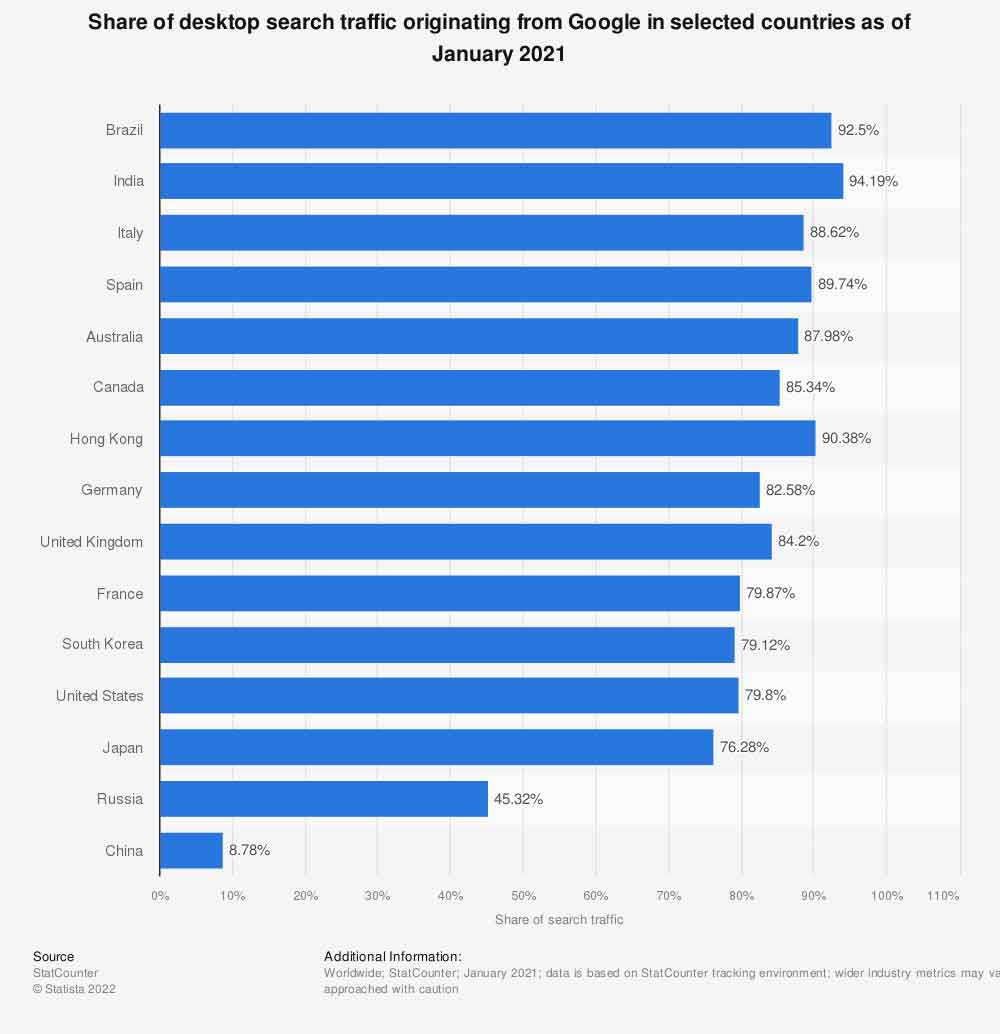Do you want to reach a global audience? Are you looking for ways to improve your website’s international SEO? If so, you’ve come to the right place! We will discuss everything you need to know about international SEO. We’ll provide tips and tricks for optimizing your website for different countries and regions around the world. So whether you’re just starting with international SEO or looking for ways to take your efforts to the next level, we have something for you!
Understanding International SEO
Google accounts for most search traffic in many countries outside the U.S. For example, 92.% of search traffic in Brazil originates from Google. In India, it’s 94.19 percent. If you want to reach a global audience, it’s important to understand how international SEO works and how to optimize your website for different countries and regions around the world.
Here’s a graph that depicts the percentage of search traffic originating from various countries.
How Does It Work?
Google and other search engines are engineered to match search results to the language and location of the user. When you perform a Google search, the engine looks at your IP address and compares it to its database of known IP addresses. If it can’t determine your location, it will prompt you to select your country from a list.
Once Google knows your location, it returns relevant results to your area. This is why international SEO is so important—it lets search engines know that your site has content suitable for searchers based in a particular country or users searching for products or services like yours in a specific language.
Why Is It Important?
If you want to reach a global audience, optimizing your website for international SEO is essential. By improving your website’s international SEO, you can improve your rankings in Google and other search engines and attract more visitors worldwide.
There are many benefits of optimizing your website for international SEO:
- Improved rankings in Google and other search engines
- Increased traffic from global audiences
- Better visibility for your brand or product worldwide
- Increased sales and conversions from global visitors
What Makes a Strong International SEO Strategy?
A strong international SEO strategy allows for adaptation for various regions or countries. That means you need to tailor your content to the cultural differences in each language or country you want to provide content for.
It’s important to localize your content rather than just translate it. When you localize your content, you take into account each market’s unique cultural and linguistic characteristics. This helps ensure that your website provides an optimal user experience for global audiences.
There are many ways to localize your website’s content:
- Use regionally specific keywords and phrases in your titles, descriptions, and other metadata
- Translate your website’s text into multiple languages
- Create localized versions of your website (e.g., using different domain names or subdomains)
- Adapt your website’s design and layout for different regions
- Produce regionally specific content (e.g., news, blog posts, etc.)
Do You Need International SEO?
If you want to reach a global audience, the answer is yes! International SEO is essential for businesses that want to expand their reach beyond their home country. By optimizing your website for international SEO, you can improve your rankings in Google and other search engines and attract more visitors worldwide.
But before start investing in international SEO, you should consider answering the following questions:
Do you have an international audience?
You can use Google Analytics to check for your traffic demographics. If you see a good amount of international traffic coming in, then this could be an indication that there’s a demand for your services/ products in foreign countries and that investing in international SEO could be fruitful.
What are the different languages your visitors are using on their browsers?
You can easily check for this information in the audience section of your Google analytics. This will help you understand what your users are looking for.
Are other businesses similar to yours doing good in the international market?
You can use VPN to check how your competitors are doing in other countries. If they have a good reputation in the selected markets, they’ll appear in your searches.
What are people searching for in the country that you want to target?
Use keyword research to check the performance of your competitors. This is very similar to doing general keyword research. You can use SEMRUSH or any other keyword research tool.
Do you have the expertise and selling capabilities for the market you’re targeting?
This is very important because if you don’t have the expertise it requires then going international will be a really bad idea. SEO is not just about getting traffic but helping users find what they are looking for.
Implementing International SEO
Here are five steps to help you get started:
Step One: Define Your International SEO Strategy
Before you start anything, you need to have a plan. This means defining your goals and objectives for international SEO and understanding the different challenges and opportunities you’ll face when expanding your business globally.
Identify Your Target Audience
Once you know what you’re aiming for, it’s time to identify your target audience. This includes understanding which countries or regions you want to focus on and what languages those audiences are using.
Research the Competition
Now that you know who your target audience is, it’s important to research the competition. This includes studying how they’re doing in international search engines and identifying any gaps in their strategies that you can exploit.
Select Strategic Keywords
After you’ve gathered all of this information, it’s time to select keywords. These should be relevant to your target audience and the countries you’re targeting.
Step Two: Select the URL Structure for Your International Sites
One of the first things you’ll need to do is select a URL structure for your international sites. You have three main options:
- Adapt your website’s domain name (e.g., add country code top-level domains – ccTLDs)
- Subdomains (e.g., de.yourdomain.com)
- Subdirectory (e.g., yourdomain.com/de)
The best option will depend on some factors, such as your business goals, the competition, and your target audience’s preferences.
Step Three: Translate Your Website into Other Languages
Once you’ve selected a URL structure for your international sites, it’s time to translate your website into other languages. This includes creating translated versions of your content – including titles, meta descriptions, images, and even navigation menus. You can use professional translation services or machine translation tools like Google Translate to help with this process.
Ensure that all of your translations are accurate and high quality, as poor translations can hurt your SEO efforts rather than help them.
Step Four: Customize Your Content for International Audiences
To appeal to international audiences, you’ll need to customize your content accordingly. This includes tailoring your messaging to fit the cultural beliefs and preferences of those audiences and using local currencies and measurements.
You should also consider translating your website into other languages and the ones you’ve already translated your content into. This will ensure that all of your site’s visitors can easily understand the content on your website.
Step Five: Prioritize Your Target Countries
Once you’ve implemented these steps, it’s time to start prioritizing your target countries. This means focusing your international SEO efforts on the most important countries to your business and allocating more resources to those countries.
You can use a variety of tools to help you with this process, such as Google Analytics and Alexa Traffic Rankings.
International SEO Best Practices:
Language is important: make sure that all of your website’s content is translated into the languages used by your target audiences.
Localize your content: tailor your messaging to fit international audiences’ cultural beliefs and preferences.
Use local currencies and measurements: make it easy for international visitors to understand your website’s content by using local currencies and measurements.
Plan for international link building: build links from websites in other countries to your international sites.
International SEO can be a complex process, but by following these steps, you’ll reach international audiences online. For more information on international SEO, please see the following resources:
- Google Internationalization Guide: https://support.google.com/webmasters/answer/1722133?hl=en
- Google Webmaster Central Blog: https://webmasters.googleblog.com/
- MOZ Internationalization Guide: https://moz.com/learn/seo/internationalization
- Hreflang Tag Generator: https://techwyze.net/hreflang-tag-generator/#urls
- Yoast SEO Plugin for WordPress: https://yoast.com/wordpress/plugins/seo/#language-settings










2 comments
Raheem Rowe
November 2, 2022 at 1:42 pm
Thanks for always providing such a wealth of knowledge on your blog. This guide step to international SEO can really help to reach international audiences.
Carson Peterson
January 2, 2023 at 3:23 pm
This is a complete guide to keyword research and search engine optimization, absolutely written by an expert in the field.
Comments are closed.